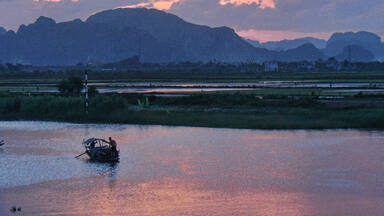Great Himalayan National Park Conservation Area
Great Himalayan National Park Conservation Area
This National Park in the western part of the Himalayan Mountains in the northern Indian state of Himachal Pradesh is characterized by high alpine peaks, alpine meadows and riverine forests. The 90,540 ha property includes the upper mountain glacial and snow meltwater sources of several rivers, and the catchments of water supplies that are vital to millions of downstream users. The GHNPCA protects the monsoon-affected forests and alpine meadows of the Himalayan front ranges. It is part of the Himalaya biodiversity hotspot and includes twenty-five forest types along with a rich assemblage of fauna species, several of which are threatened. This gives the site outstanding significance for biodiversity conservation.
Description is available under license CC-BY-SA IGO 3.0
Aire de conservation du Parc national du Grand Himalaya
Ce parc national se trouve dans le secteur occidental de l’Himalaya, dans l’État indien septentrional de l’Himachal Pradesh. Il se caractérise par de hauts sommets alpins, des prairies alpines et des forêts riveraines. Les 90 540 ha du bien englobent les sources, nées des hautes montagnes glacées et de la fonte des neiges, de plusieurs fleuves et les bassins-versants des eaux qui alimentent de façon vitale des millions de personnes vivant en aval. Le site protège les forêts touchées par la mousson et les prairies alpines des chaînes frontales de l’Himalaya. Le bien, qui protège aussi une partie du « haut lieu de biodiversité » de l’Himalaya, comprend 25 types de forêts et un riche assemblage associé d’espèces de la faune, dont plusieurs sont menacées. Cela lui confère une importance exceptionnelle pour la conservation de la biodiversité.
Description is available under license CC-BY-SA IGO 3.0
Gran Parque Nacional del Himalaya
Situado al norte de la India, en la parte occidental de la cordillera del Himalaya que forma parte del territorio del Estado de Himachal Pradesh, el Gran Parque Nacional del Himalaya (GHNPCA) se extiende por una superficie de 90.540 hectáreas y se caracteriza por la presencia de picos montañosos de gran altitud, praderas alpinas y bosques fluviales. Las aguas de deshielo de los glaciares y neveros de alta montaña nutren las fuentes de toda una serie ríos, así como captaciones de agua que son vitales para el abastecimiento de poblaciones de varios millones de personas que viven en los cursos inferiores de éstos. El Gran Parque protege las praderas alpinas y los bosques monzónicos de los contrafuertes de la cadena del Himalaya afectados por las actividades humanas. Además, forma parte del área de rica biodiversidad del Himalaya ya que comprende 25 tipos de bosques diferentes y un conjunto sumamente variado de especies animales, algunas de las cuales se hallan en peligro de extinción. Todas estas circunstancias hacen que el sitio revista una importancia excepcional para la conservación de la diversidad biológica.
source: UNESCO/CPE
Description is available under license CC-BY-SA IGO 3.0
大ヒマラヤ国立公園
source: NFUAJ
Nationaal park Groot Himalaya
Source: unesco.nl
ग्रेट हिमालयन राष्ट्रीय उद्यान संरक्षण क्षेत्र
उत्तर भारत के राज्य हिमाचल प्रदेश में हिमालय पर्वत के पश्चिमी भाग में स्थित इस राष्ट्रीय उद्यान में ऊंची-ऊंची अल्पाइन की चोटियां, अल्पाइन घास और तटवर्ती वन हैं। पहाड़ी के ऊपरी हिस्से में 90,540 हेक्टेयर सम्पदा में फैले इस उद्यान में कई हिमनद और बर्फ के पिघलने से बने पानी के स्रोत तथा जलाशय हैं, जो अनुप्रवाह क्षेत्र में रहने वाले लाखों लोगों की जलापूर्ति के लिए महत्वपूर्ण हैं। जीएचएनपीसीए हिमालय के सामने वाली पहाड़ियों के मानसून-प्रभावित वनों और अल्पाइन घास के मैदानों का संरक्षण करता है। यह हिमालय जैव विविधता वाले क्षेत्र का हिस्सा है, तथा इसमें पच्चीस प्रकार के वनों के साथ ही कुछ ऐसी पशु प्रजातियां हैं जो लुप्तप्राय हैं। इसलिए इस क्षेत्र को जैव विविधता संरक्षण के लिए अत्यधिक महत्व दिया गया है।
Source: India
Outstanding Universal Value
Brief synthesis
The Great Himalayan National Park Conservation Area is located in the western part of the Himalayan Mountains in the northern Indian State of Himachal Pradesh. The 90,540 ha property includes the upper mountain glacial and snow melt water source origins of the westerly flowing Jiwa Nal, Sainj and Tirthan Rivers and the north-westerly flowing Parvati River which are all headwater tributaries to the River Beas and subsequently, the Indus River. The property includes an elevational range from high alpine peaks of over 6,000m a.s.l to riverine forest at altitudes below 2,000m a.s.l. The Great Himalayan National Park Conservation Area encompasses the catchments of water supplies which are vital to millions of downstream users.
The property lies within the ecologically distinct Western Himalayas at the junction between two of the world’s major biogeographic realms, the Palearctic and Indomalayan Realms. Displaying biotic elements from both these realms, the Great Himalayan National Park Conservation Area protects the monsoon affected forests and alpine meadows of the Himalayan front ranges which sustain a unique biota comprised of many distinct altitude-sensitive ecosystems. The property is home to many plants and animals endemic to the region. The Great Himalayan National Park Conservation Area displays distinct broadleaf and conifer forest types forming mosaics of habitat across steep valley side landscapes. It is a compact, natural and biodiverse protected area system that includes 25 forest types and an associated rich assemblage of fauna species.
The Great Himalayan National Park Conservation Area is at the core of a larger area of surrounding protected areas which form an island of undisturbed environments in the greater Western Himalayan landscape. The diversity of species present is rich; however it is the abundance and health of individual species’ populations supported by healthy ecosystem processes where the Great Himalayan National Park Conservation Area demonstrates its outstanding significance for biodiversity conservation.
Criterion (x): The Great Himalayan National Park Conservation Area is located within the globally significant “Western Himalayan Temperate Forests” ecoregion. The property also protects part of Conservation International’s Himalaya “biodiversity hot spot” and is part of the BirdLife International’s Western Himalaya Endemic Bird Area. The Great Himalayan National Park Conservation Area is home to 805 vascular plant species, 192 species of lichen, 12 species of liverworts and 25 species of mosses. Some 58% of its angiosperms are endemic to the Western Himalayas. The property also protects some 31 species of mammals, 209 birds, 9 amphibians, 12 reptiles and 125 insects. The Great Himalayan National Park Conservation Area provides habitat for 4 globally threatened mammals, 3 globally threatened birds and a large number of medicinal plants. The protection of lower altitude valleys provides for more complete protection and management of important habitats and endangered species such as the Western Tragopan and the Musk Deer.
Integrity
The property is of a sufficient size to ensure the natural functioning of ecological processes. Its rugged topography and inaccessibility together with its location within a much larger ecological complex of protected areas ensures its integrity. The altitudinal range within the property together with its diversity of habitat types provide a buffer to climate change impacts and the needs of altitude sensitive plants and animals to find refuge from climate variability.
A 26,560 ha buffer zone known as an Ecozone is defined along the south-western side of the property. This buffer zone coincides with the areas of greatest human pressure and is managed in sympathy with the core values of the Great Himalayan National Park Conservation Area. The property is further buffered by high mountain systems to the north-west which include several national parks and wildlife sanctuaries. These areas also offer scope to progressively increase the size of the World Heritage property.
Human settlement related threats pose the greatest concern and include agriculture, localised poaching, traditional grazing, human-wildlife conflicts and hydropower development. Tourism impact is minimal and trekking routes are closely regulated.
Protection and management requirements
The property is subject to sound legal protection, however, this needs to be strengthened to ensure consistent high level protection across all areas. This pertains to the transition of some areas from wildlife sanctuary to national park status. Tirthan and Sainj Wildlife Sanctuaries are designated in recognition of their ecological and zoological significance and are subject to wildlife management objectives, and a higher level of strict protection is provided to Great Himalayan National Park which is a national park. National parks under the Wildlife Protection Act, 1972 provide for strict protection without human disturbance.
The property’s boundaries are considered appropriate and an effective management regime is in place including an overall management plan and adequate resourcing. The property has a buffer zone along its south-western side which corresponds to the 26,560 ha Ecozone, the area of greatest human population pressure. Continued attention is required to manage sensitive community development issues in this buffer zone and in some parts of the property itself.
The sensitive resolution of access and use rights by communities is needed to bolster protection as is fostering alternative livelihoods which are sympathetic to the conservation of the area. Local communities are engaged in management decisions; however more work is needed to fully empower communities and continue to build a strong sense of support and stewardship for the Great Himalayan National Park Conservation Area.
Included within the property is the Sainj Wildlife Sanctuary with 120 inhabitants and the Tirthan Wildlife Sanctuary, which is uninhabited but currently subject to traditional grazing. The inclusion of these two Wildlife Sanctuaries supports the integrity of the nomination; however, it opens up concerns regarding the impacts of grazing and human settlements. Both these aspects are being actively managed, a process that will need to be maintained. The extent and impacts of high pasture grazing in the Tirthan area of the property needs to be assessed and grazing phased out as soon as practicable. Other impacts arising from small human settlements within the Sainj area of the property also need to be addressed as soon as practicable.


